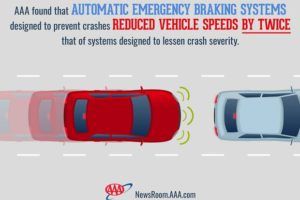

New test results from AAA reveal that automatic emergency braking systems – the safety technology that will soon be standard equipment on 99 percent of vehicles – vary widely in design and performance. All the systems tested by AAA are designed to apply the brakes when a driver fails to engage. However, those that are designed to prevent crashes reduced vehicle speeds by nearly twice that of those designed to slow the car enough to lessen crash severity. While any reduction in speed offers a significant safety benefit to drivers, AAA warns that automatic braking systems are not all designed to prevent collisions and urges consumers to fully understand system limitations before getting behind the wheel.
“AAA found that two-thirds of Americans familiar with the technology believe that automatic emergency braking systems are designed to avoid crashes without driver intervention,” said John Nielsen, AAA’s managing director of Automotive Engineering and Repair. “The reality is that today’s systems vary greatly in performance, and many are not designed to stop a moving car.”
In partnership with the Automobile Club of Southern California’s Automotive Research Center, AAA evaluated five 2016 model-year vehicles equipped with automatic emergency braking systems for performance within system limitations and in real-world driving scenarios that were designed to push the technology’s limits. Systems were tested and compared based on the capabilities and limitations stated in the owner’s manuals and grouped into two categories – those designed to slow or stop the vehicle enough to prevent crashes, and those designed to slow the vehicle to lessen crash severity.
“Automatic emergency braking systems have the potential to drastically reduce the risk of injury from a crash,” said Megan McKernan, manager of the Automobile Club of Southern California’s Automotive Research Center. “When traveling at 30 mph, reducing speed by just 10 mph can reduce the energy of crash impact by more than 50 percent.”
After more than 70 trials, tests reveal:
In addition to the independent testing, AAA surveyed U.S. drivers to understand consumer purchase habits and trust of automatic emergency braking systems. Results reveal:
“When shopping for a new vehicle, AAA recommends considering one equipped with an automatic emergency braking system,” continued Nielsen. “However, with the proliferation of vehicle technology, it’s more important than ever for drivers to fully understand their vehicle’s capabilities and limitations before driving off the dealer lot.”
For its potential to reduce crash severity, 22 automakers representing 99 percent of vehicle sales have committed to making automatic emergency braking systems standard on all new vehicles by 2022. The U.S. Department of Transportation said this voluntary agreement will make the safety feature available on new cars up to three years sooner than could be achieved through the formal regulatory process. According to the National Highway Traffic Safety Administration, rear-end collisions, which automatic emergency braking systems are designed to mitigate, result in nearly 2,000 fatalities and more than 500,000 injuries annually. Currently, 10 percent of new vehicles have automatic emergency braking as standard equipment, and more than half of new vehicles offer the feature as an option.
AAA’s testing of automatic emergency braking systems was conducted on a closed course at the Auto Club Speedway in Fontana, California. Using instrumented vehicles and a state-of the-art robotic “soft car” that allowed for collisions without vehicle damage, AAA collected vehicle separation, speed and deceleration data in a variety of crash scenarios designed to mirror real-world driving conditions. The testing was designed to build on previous testing by the Insurance Institute for Highway Safety.
Source: AAA Southern California